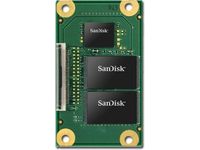SanDisk Flash SSDs for Lowest-Cost PCs
If you don’t really need a lot of capacity or highest performance, then you typically focus on cost. Asus’s EEE PC notebooks or lowest-cost computers are excellent examples, as these need convenient and affordable storage, but do not require large capacities or stellar performance. A few gigabytes are often enough to store an operating system plus the most important user data, which is exactly the market segment SanDisk is after.
SanDisk is showing a new flash memory product line, which is based on a parallel UltraATA interface. Consequently, the new products are named pSSDs. SanDisk says that these were developed for lowest-cost computers, which it refers to as ULCPCs (ultra-low-cost PCs). While performance wasn’t the primary objective, smallest physical dimentions and low power requirements were on top of the list to be suitable for ultra-small computing devices.
The pSSD will be available starting in August at capacities of 4, 8 and 16 GB. First shipments will be at the 16 GB capacity point. The manufacturer says that its drives reach a read throughput performance of 39 MB/s, which is an average value and roughly as fast as a 2-3 year old notebook hard drive. Write operations can be performed at 17 MB/s, which users of lowest-cost solutions should be able to live with.
We did not receive information about pricing, but SanDisk refers to the pSSDs as a highly cost-effective solution.
Get Tom's Hardware's best news and in-depth reviews, straight to your inbox.
-
draxssab So there is only few advantages over stadard HDD, if it's slow and short on space. So only the low power consumption seems to justify it. But if it's really cheap, this could be a good productReply

